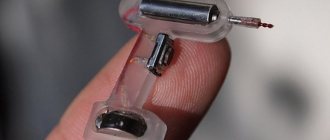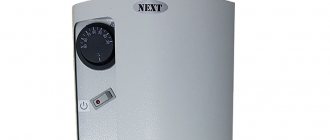To ensure a comfortable stay, it is necessary to use automation. Radio amateurs offer a lot of useful electronic circuits for home and everyday life. However, in some sources there are circuit diagrams that do not work at all, and you have to spend time improving them. The reason is the lack of a full description of the operating principle and a list of parts.
Do-it-yourself electronic automation circuits for home and everyday life
To ensure a comfortable stay, it is necessary to use automation. Radio amateurs offer a lot of useful electronic circuits for home and everyday life. However, in some sources there are circuit diagrams that do not work at all, and you have to spend time improving them. The reason is the lack of a full description of the operating principle and a list of parts.
Why do you need a limit thermostat?
A mandatory element of such a scheme is a limit thermostat.
This is a protective device that will turn off your electric boiler if it goes into what is called a breakdown.
For example, the circulation pump has stopped working or a blockage has formed somewhere. As a result, the temperature began to rise sharply and exceeded permissible values.
You set this temperature yourself using a manual regulator.
Since this is a protective element that must completely “extinguish” the boiler, it must be connected in series to the control phase break, as in the figure below.
General information about automation
Automation refers to mechanisms, instruments and devices that operate or control the operation of other components without human intervention. It is used in almost all areas: in enterprises and at home. To increase the reliability and productivity of equipment, it is necessary to eliminate as much as possible the factor of human actions that affects the result of the work. Automation can significantly improve the quality of life by freeing people from routine work.
Automation also makes it possible to prevent accidents in any industry that threaten equipment, life and health of people. The last two reasons for the use of automation tools are very important, since they help ensure a high level of safety in the enterprise. This is very important not only for the employer, but also for the employees.
It is necessary to constantly monitor the operation of electronics, as they may fail. Due to the high efficiency of devices, automation in everyday life has become widespread among craftsmen.
Easy adjustment of electric heating power
The closed or open position of the contacts depends on whether voltage is applied or removed from its control coil. It turns out that in order to assemble the automation, we must supply control signals (voltage) to the terminals of these same coils through some other elements.
The coil has two contacts A1, A2.
When purchasing, pay attention that starters can come with 380V and 220V coils. It's better to take the last option.
In this case, you directly connect the neutral conductor to one of the contacts, and install microswitch buttons into the gap of the second.
What are they needed for? Thanks to them, you have the opportunity to turn on 1,2 or 3 heating elements alternately, thereby increasing or decreasing the heating power.
For example, the temperature outside the window is -5C. You press one button and start up just one heating element with a power of 2 kW. The frost hit -25C, press all three buttons and increase the power three times.
In this case, the number of heating stages will depend on the rated power of each heating element. If they are all 2 kW, that’s only three steps.
But if one is 2 kW, the second is 3 kW, and the third is 4 kW, then the number of stages automatically increases to seven!
Everything will depend on which phases (heating elements) are connected and in what sequence.
- individually 2kW – 3kW – 4kW
- together 2kw+3kw+4kw
- separately 2kW+3kW
- separately 2kW+4kW
- separately 3kW+4kW
That is, thanks to these small buttons and separate modular starters, you get the simplest circuit for adjusting the power of electric heating.
The current in the coil control circuits is very small (several milliamps). Accordingly, there is no need to install full-fledged switches here.
All these three microswitches must be supplied with one phase. Let's say phase C. Take it from the lower contacts of the input circuit breaker.
It is from this point that the entire further automation scheme begins.
Electronic circuits
Radio amateurs offer electrical circuit diagrams of various home automation devices with a description and list of parts. They are simple and reliable. The radio components that are used in them can be purchased at any specialized store. Before manufacturing devices, you should prepare and think through design features. A simple algorithm that all radio amateurs use will help with this:
- make a list of necessary radioelements;
- become familiar with the operating principle of the device;
- find an electrical circuit diagram of home automation;
- think over the design features of the device;
- prepare tools: soldering iron, tin, solder, pliers, side cutters, etc.;
- the presence of a measuring device is mandatory;
- the workplace should be comfortable;
- buy the necessary radioelements and parts for the structure.
A list of necessary radio elements is necessary for comfortable work, since it is not very pleasant to constantly run to the store for radio components that have not been purchased. To manufacture a device, you should find its electrical circuit, familiarize yourself in detail and understand its principle of operation, since this will greatly facilitate further diagnostics of the operation of the product. Construction features and design are also important. This issue should be approached very seriously.
The quality of work is determined not only by the internal “filling” of the product, but also by the design features. The latter plays an important role in its trouble-free operation. For example, if the device gets hot, then you should consider a cooling system. Besides, it’s not very pleasant to watch an ordinary rusty box. Appearance is also of great importance, as it shows the accuracy of the craftsman.
The presentable appearance of the product can contribute to additional income. Preparation of the workplace and tools is one of the reasons for the high productivity of the craftsman, since he is not distracted by the search for the latter.
The presence of the device is very important, since after purchasing the radio components they should be checked again. A faulty radio component can damage other elements of the circuit. The device must measure resistance, voltage and perform continuity testing of semiconductor elements. A simple multimeter is suitable for these purposes. It is very important to calculate the cost of the device, since this is a very interesting activity. For example, a radio amateur decided to make an electronic alarm. He will be interested in knowing the cost of parts and labor in order to compare with store-bought counterparts.
Selection of input machine and starters
The circuit diagram of an electric boiler automation always begins with the supply of voltage through the input circuit breaker.
Electric heating usually implies the presence of a three-phase 380V input. This means that the machine must be three-pole.
Please pay special attention that this must be one three-pole switch, and not three separate single-pole ones.
In the event of a short circuit and damage to the heating element of any phase, the protection must stop supplying voltage to all phases.
After the introductory circuit breaker, the phase conductors need to be separated.
This is done using electromagnetic starters.
It is they who are responsible for the main work on automatic switching of the electrical network. You turn the machine on and off manually, and the starter will do this without your participation, based on the supply of control voltage from the corresponding sensors.
In this case, unlike an automatic machine, buy three separate single-phase modular starters. Old models such as PML, PMA, KMI will not work here. And the point is not at all in their noisy work and loud clicks.
A modular three-phase unit in a single housing will also not be suitable for our circuit.
The most important advantage of single-phase ones is the ability to manually and very simply adjust the power of the electric boiler. This will be discussed in more detail below.
The heating elements (heating elements, electrodes) of the heating boiler are connected to the power terminals of each contactor.
Adjusting the water temperature
Besides security, we need one more element. A control element that will periodically turn it on and off to maintain the set water temperature.
This device is a working thermostat.
Don't confuse it with the ultimate. In the limit there is a manually reset button, which, when triggered, prevents the sensor from turning on independently.
That is, when it triggered once, you will need to inspect the entire system and circuit in order to understand the reason for the triggering. And only after that, by pressing this button, the heating can be started again.
The working thermostat turns on and off without your participation, depending on the temperature set on it.
This thermostat is installed after the limit, again in an open circuit.
Thus we received a security element and a control element. In principle, this is the most primitive scheme No. 1 for automatic electric heating.
Regulator assembly
Before assembling a triac power regulator according to the circuit, you need to perform a number of actions:
Lay out the tracks on the board and prepare the sites on which you want to install the elements. Provide in advance places for mounting the triac and radiator. Install all elements on the board and solder them. If you do not have the opportunity to make a printed circuit board, you can use surface mounting. The wires that connect all elements should be as short as possible
Pay attention to whether the polarity is correct when connecting the triac and diodes. If there are no markings, test the elements with a multimeter
Check the circuit using a multimeter in resistance mode. Attach the triac to the radiator; it is advisable to use thermal paste for better surface contact. The entire circuit can be installed in a plastic case. Set the variable resistor knob to the far left position and turn on the device. Measure the voltage value at the device output. If you rotate the resistor knob, the voltage should increase smoothly.
As you can see, a self-made triac power regulator is a useful design that can be used in everyday life with almost no restrictions. Repair of this device is cheap, since the cost is quite low.
How to make a lathe from a drill?
To save on spare parts and simplify assembly, it is allowed to use a drill as a drive. This design has its advantages:
- the structure can be assembled and disassembled at any time;
- It is quite easy to carry and transport, because it is quite easy to disassemble it;
- cost savings;
But this method has its drawbacks, because the drill has a low torque, which will make it almost impossible to process large parts.
To make this type of metal lathe, you need the usual parts (except for the motor and headstock). The function of the headstock is taken over by the drill.
Due to the compactness of the machine, the role of the bed can be performed by a flat surface or a workbench. The drill itself can be secured using a clamp or clamp.
The following safety precautions must be observed:
- Upon completion of the machine layout, it is necessary to check the serviceability.
- the electric motor in the machine must be protected by a casing;
- the power of the electric motor must be covered by your electrical network;
- the working tool can only be positioned parallel to the surface of the workpiece. Otherwise it will bounce off;
- when processing the end planes, the latter must rest against the tailstock;
- you can start working only using eye protection from chips;
- After work, the workplace must be left clean.
A woodworking machine requires the same safety precautions as a metalworking machine.
Features of use
Weather-compensating automation (PA) is used in two types of boilers.
Wall
Automation is built into most of these devices by the manufacturer. They are hung on a vertical surface during installation, which is why they got the corresponding name. A medium-sized device takes up little space. Recommended for use in small private houses where it is impossible to allocate a separate room for the boiler room. Compared to the floor version, the wall version is cheaper. PA involves installing a sensor that measures outdoor temperature.
Photo 1. Wall-mounted boiler installed in the kitchen. Typically, such devices are equipped with weather-sensitive automation.
Floor
The use of a floor-standing boiler is justified in a large country house. The cost of the device is higher than that of its wall-mounted counterpart, but operation is cheaper.
Rare models have a built-in controller - you will have to buy it separately. You will also need to purchase and install a lot of additional equipment: mixing units, terminals, hydraulic system. For strapping you need a place, preferably a separate room. In addition, you will need to hire a specialist for connection and debugging. The total amount will be 100 – 150 thousand rubles.
Smart home elements
Home automation elements include sensors (such as temperature, daylight, or motion detection), controllers, and actuators such as motorized valves, switches, motors, and others.
- Electromagnetic relay: device, marking, types + details of connection and adjustment
HVAC
house control diagram
This heating, ventilation and air conditioning, HVAC can control temperature and humidity, for example, an internet control thermostat allows the homeowner to remotely control the building's heating and air conditioning systems, the system can automatically open and close windows, turn on radiators and boilers, and heated floors.
Lighting
These lighting control mechanisms can be used to control household lights and appliances. This also includes a natural lighting system, the operation of blinds or curtains.
Photo - Smart home diagram
Audio-visual
This category includes audio, video signals for security. This includes:
- Presence effect of remote control (This is the most modern technology that is used to increase safety). It involves turning on the lights and playing music.
- Presence simulation
- Temperature regulation
- Brightness adjustment (electric lamps, street lighting)
- Security (alarm, blinds).
Operating principle
When setting up the controller, a “curve” is specified . With its help, the program calculates the need to heat the room. The initial position of the curve is the point at which the temperatures of the coolant and the environment are equal. Typically this is 20 degrees Celsius. After calibration, the device independently monitors the need for temperature changes.
Manufacturers specify several curves in the PA so that setup does not take extra time. Having selected the program, the specialist starts the system. Further, it functions independently.
For better synchronization, it is necessary to install two sensors - one outside, the second inside.
By checking the readings, the system will not produce additional heating at a comfortable room temperature.
For this reason, it is necessary to correctly select the room in which the sensor will be installed.
Warming up or cooling the coolant takes time, so the heating cannot adapt sharply to temperature changes.
Controller
The controller is the core of the hardware device. It monitors sensor readings and sets the room temperature. The factory functions of the device are responsible for heating, and also inform the owner about problems. Custom settings are designed to maintain maximum comfort.
Build process
Work begins by removing the secondary winding from the transformer. This operation requires care. It is carried out using an angle grinder.
Next, the plate core is removed from the surface of the secondary winding. After the operation on the transformer, you can find parts cut off on both sides. With their help, the work will be of better quality. Ideally, it is necessary to ensure that the insulating layer on the core is free of any defects.
Then the magnetic shunt is attached. During its normal functioning, the operation of a home-made welding machine is carried out. Then the transformer is rewound using a thick wire made of copper material. If the core is damaged, it must be repaired. If the defect is minimal, then the area is isolated.
Fixation of the electrodes on the upper and lower parts of the bar is carried out with self-tapping screws. Then the winding wires are connected to them. It is necessary to secure the copper terminals correctly using pliers, which is usually very difficult for novice craftsmen. The design is ready
Then you need to check whether anything can be welded using the unit, and it is important to follow safety regulations.
Usually, assembling a welding machine is not difficult even for those people who have minimal knowledge of technology. To do this, you can use step-by-step instructions with photos at all stages, of which there are a large number on the Internet.
Homemade chargers
| Car chargers |
Various circuits of homemade car battery chargers, usually these amateur radio designs consist of a step-down transformer, a full-wave rectifier connected to the secondary winding and a rheostat that sets the required charging current and various amateur radio “Know How”
| Charging nickel batteries |
These chargers are used when charging various types of nickel batteries with direct current. The circuitry of a typical charger for such batteries usually has two operating modes, automatic shutdown and generation of an audible or visual signal at the end of the charging process.
| Charging Lithium Ion Batteries |
Introductory selection of charger circuits
and other useful lithium ion battery designs
| USB charger with AA batteries for autonomous travel |
What to do if we find ourselves far from the benefits of civilization and the battery of your “electronic friend” is completely discharged, and there is nowhere to charge it. Self-contained USB chargers with standard batteries will come to your aid, and you can take them with you as much as you like.
| Charging AA batteries |
Charger circuit from an old computer power supply, used to charge AA batteries
| Diagrams of bugs, radio transmitters and other spy equipment |











